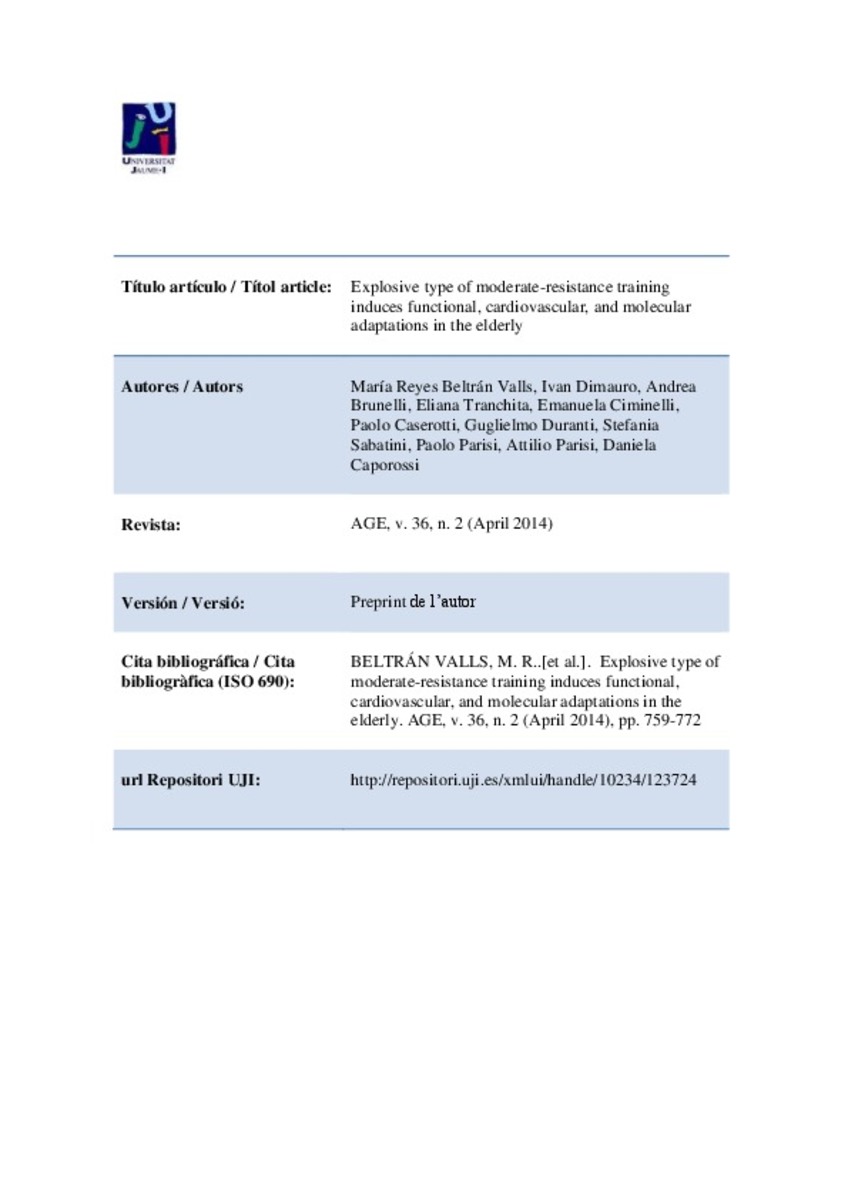Mostrar el registro sencillo del ítem
Explosive type of moderate-resistance training induces functional, cardiovascular, and molecular adaptations in the elderly
| dc.contributor.author | Beltran Valls, Maria Reyes | |
| dc.contributor.author | Dimauro, Ivan | |
| dc.contributor.author | Brunelli, Andrea | |
| dc.contributor.author | Tranchita, Eliana | |
| dc.contributor.author | Ciminelli, Emanuela | |
| dc.contributor.author | Caserotti, Paolo | |
| dc.contributor.author | Duranti, Guglielmo | |
| dc.contributor.author | Sabatini, Stefania | |
| dc.contributor.author | Parisi, Paolo | |
| dc.contributor.author | Parisi, Attilio | |
| dc.contributor.author | Caporossi, Daniela | |
| dc.date.accessioned | 2015-06-16T07:11:58Z | |
| dc.date.available | 2015-06-16T07:11:58Z | |
| dc.date.issued | 2014-04 | |
| dc.identifier.citation | BELTRÁN VALLS, M. R.; DIMAURO, I.; BRUNELLI, A.; TRANCHITA, E.; CIMINELLI, E.; CASEROTTI, P.; DURANTI, G.; SABATINI, S.; PARISI, P.; PARISI, A.; CAPOSOSSI, D. Explosive type of moderate-resistance training induces functional, cardiovascular, and molecular adaptations in the elderly. AGE, v. 36, n. 2 (April 2014), pp. 759-772 | ca_CA |
| dc.identifier.uri | http://hdl.handle.net/10234/123724 | |
| dc.description.abstract | Current recommendations aimed at reducing neuromuscular and functional loss in aged muscle have identified muscle power as a key target for intervention trials, although little is known about the biological and cardiovascular systemic response in the elderly. This study investigated the effects of 12 weeks of low-frequency, moderate-intensity, explosive-type resistance training (EMRT) on muscle strength and powerin oldcommunity-dwellingpeople(70–75years), monitoring functional performance linked to daily liv- ing activities (ADL) and cardiovascular response, as well as biomarkers of muscle damage, cardiovascular risk, and cellular stress response. The present study provides the first evidence that EMRT was highly effective in achieving a significant enhancement in muscular strength and power as well as in functional performance without causing any detrimental modification in cardiovascular, inflammatory, and damage parameters. Moreover, trained elderly subjects showed an adaptive response at both systemic and cellular levels by modulation of antioxidant and stress-induced markers such as myeloperoxidase (MPO), heat shock protein 70 (Hsp70) and 27 (Hsp27), and thioredoxin reductase 1 (TrxR1). | ca_CA |
| dc.format.extent | 19 p. | ca_CA |
| dc.format.mimetype | application/pdf | ca_CA |
| dc.language.iso | eng | ca_CA |
| dc.publisher | Springer | ca_CA |
| dc.relation.isPartOf | AGE, v. 36, n. 2 (April 2014) | ca_CA |
| dc.rights.uri | http://rightsstatements.org/vocab/CNE/1.0/ | * |
| dc.subject | Strength training | ca_CA |
| dc.subject | Elderly | ca_CA |
| dc.subject | Hemodynamic parameters | ca_CA |
| dc.subject | HSPs | ca_CA |
| dc.subject | Thioredoxin system | ca_CA |
| dc.title | Explosive type of moderate-resistance training induces functional, cardiovascular, and molecular adaptations in the elderly | ca_CA |
| dc.type | info:eu-repo/semantics/article | ca_CA |
| dc.identifier.doi | http://dx.doi.org/10.1007/s11357-013-9584-1 | |
| dc.rights.accessRights | info:eu-repo/semantics/openAccess | ca_CA |
| dc.relation.publisherVersion | http://link.springer.com/article/10.1007%2Fs11357-013-9584-1 | ca_CA |
Ficheros en el ítem
Este ítem aparece en la(s) siguiente(s) colección(ones)
-
EDU_Articles [501]







